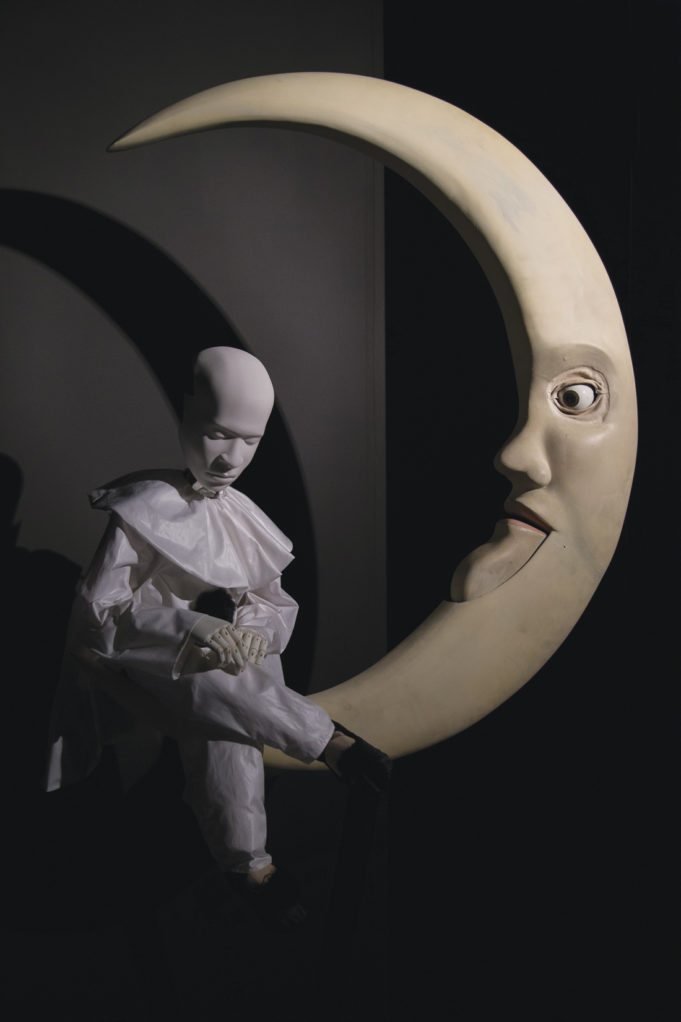Glenn Kaino is the subject of the Modern Art Museum of Fort Worth’s current Focus exhibition. Other artists like Kehinde Wiley have seen their work go from occupying just the one gallery that Focus takes up to larger shows at the Modern. This underwhelming show, however, doesn’t make a convincing case that Kaino deserves the same treatment. Though it’s tempting to put this down to the small number of pieces of his on display, too often it’s the pieces themselves that fail to impress.
A 43-year-old Japanese-American artist from Los Angeles, Kaino is a devotee of the practice of “kitbashing,” a term borrowed from model-builders that refers to taking parts intended for a model and then disregarding the instructions to create something else. He draws on previous careers as diverse as software coding and stage magic to produce his work. His assemblages “In Search of New Systems (Logarithmic)” and “In Search of New Systems (Western Skies)” are polished pieces of metal arranged against a black background in geometrical patterns. They’re pretty, but they don’t illustrate his theme of space colonization in a powerful way.
More successful is his sculptural installation “Tears of Maria,” which initially appears as a white disc against a standing steel plate coated with charcoal. However, behind the plate is a solar-powered motor that pulls moisture from the air and freezes it into the layer of frost that makes the disc white. When the sun goes down, the motors turn off and the frost melts, taking some of the charcoal with it, which is why you can see bits of charcoal on the stand on which the artwork is mounted, as well as the floor of the gallery itself. Making a piece of art that decomposes before the viewer’s eyes can be a potent statement on the passage of time and the transience of all things, but the art here is taking too long to fall apart to make that statement with any power. You’ll have to make repeat visits to get the full effect of the art. If you do, you’ll find that the formerly smooth charcoal surface has cracked in pronounced fashion in the weeks since it has been installed.
The main talking point of the exhibit is “L’ènetènafionale,” an animatronic sculpture of the pantomime character Pierrot and an anthropomorphized Moon. The piece looks kitschy and inconsequential at first, but then you’ll notice that the Moon’s eye blinks and follows viewers around the room where it’s kept. Then, every few minutes (if the piece’s motion detectors sense more than three people watching), the sculpture comes to life as the Moon sings a recorded song. The music is the same as the socialist anthem “The Internationale,” but the words belong to a language called “lunar French” that was invented by Kaino himself and a group of linguists as an amalgam of French and English intended to mimic the changes that colonization tends to wreak on language. (Indeed, the title of the piece is a word in this new language.) Meanwhile, the face of the mute, melancholy Pierrot is modeled on the face of Frantz Fanon, the 20th-century Afro-Caribbean philosopher and psychiatrist who wrote extensively about the effects of colonization on indigenous cultures. Here’s a piece that communicates Kaino’s themes in a fun, engaging way.
One of Kaino’s more overtly socially aware works — such as “Bridge,” the sculptural mobile inspired by the recent events in Ferguson, Mo., or his untitled work composed of dolls made by Zapatista activists in Chiapas, Mex. — probably would have shown to good advantage opposite “L’ènetènafionale.” As it is, the show at the Modern doesn’t quite do its artist justice.
[box_info]Focus: Glenn Kaino
Thru Apr 17. Modern Art Museum of Fort Worth,
3200 Darnell St, FW.
$4-10.
817-738-9215.[/box_info]












